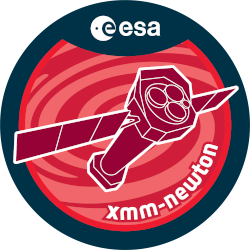

| Proposal ID | 080096 |
| Title | Possible Magnetic Field Break-out in the Neutron Star CCO 1E 1207.4-5209 |
| Download Data Associated to the proposal | https://nxsa.esac.esa.int/nxsa-sl/servlet/data-action-aio?obsno=0800960201 |
| DOI | https://doi.org/10.5270/esa-a5g7rdn |
| Principal Investigator, PI | Dr Eric Gotthelf |
| Abstract | The CCO pulsar 1E 1207.4-5209 has been an extremely stable rotator, with a weakB-field and a small spin-down rate that has remained constant to <1% over 15years. It is a unique NS whose B-field is measured as ~9E10 G, bothspectroscopically and through timing. Yet the properties of CCO pulsars cannotbe explained unless they have strong crustal magnetic fields, perhaps buried bySN fall-back material. We have just identified a glitch-like event that mayindicate changes in the B-field configuration of 1E 1207.4-5209, evidence of thefield diffusing or breaking through the crust, or possibly torque noise due tolow-level accretion from a hypothetical fall-back disk. We propose a renewedXMM-Newton campaign to follow the spectral and timing evolution of this remarkable object. |
| Publications |
|
| Instrument | EMOS1, EMOS2, EPN, OM, RGS1, RGS2 |
| Temporal Coverage | 2017-06-22T19:28:09Z/2017-12-24T12:40:46Z |
| Version | 17.56_20190403_1200 |
| Mission Description | The European Space Agencys (ESA) X-ray Multi-Mirror Mission (XMM-Newton) was launched by an Ariane 504 on December 10th 1999. XMM-Newton is ESAs second cornerstone of the Horizon 2000 Science Programme. It carries 3 high throughput X-ray telescopes with an unprecedented effective area, and an optical monitor, the first flown on a X-ray observatory. The large collecting area and ability to make long uninterrupted exposures provide highly sensitive observations. Since Earths atmosphere blocks out all X-rays, only a telescope in space can detect and study celestial X-ray sources. The XMM-Newton mission is helping scientists to solve a number of cosmic mysteries, ranging from the enigmatic black holes to the origins of the Universe itself. Observing time on XMM-Newton is being made available to the scientific community, applying for observational periods on a competitive basis. |
| Creator Contact | https://www.cosmos.esa.int/web/xmm-newton/xmm-newton-helpdesk |
| Date Published | 2019-01-10T23:00:00Z |
| Last Update | 2025-08-04 |
| Keywords | "XMM", "cco pulsars", "XMM-Newton", "magnetic field break", "torque noise", "stable rotator", "explained unless", "buried bysupernovafall", "remained constant", "field diffusing", "low level accretion", "1e 1207", "field configuration", "crustal magnetic fields" |
| Publisher And Registrant | European Space Agency |
| Credit Guidelines | European Space Agency, Dr Eric Gotthelf, 2019, 'Possible Magnetic Field Break-out in the Neutron Star CCO 1E 1207.4-5209', 17.56_20190403_1200, European Space Agency, https://doi.org/10.5270/esa-a5g7rdn |